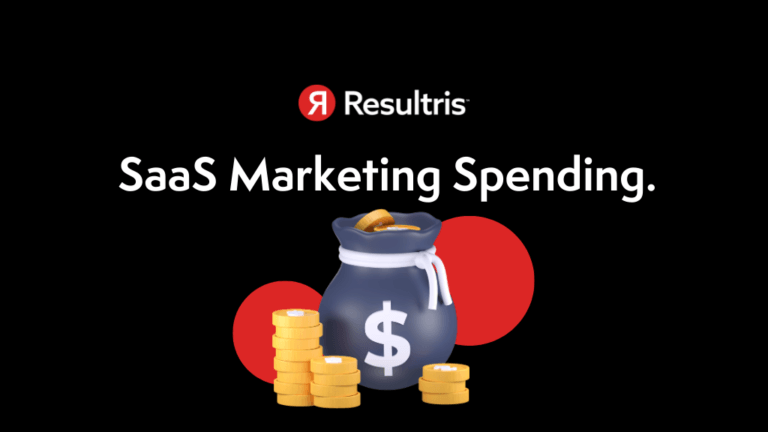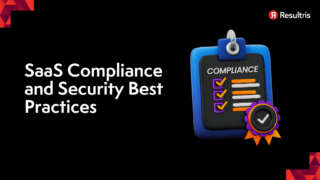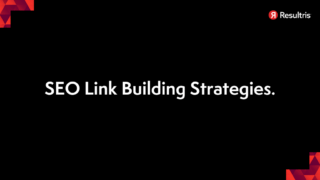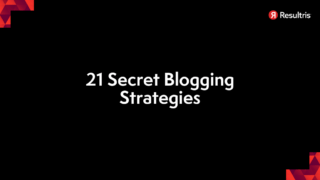

Written by: Tim Eisenhauer
Last updated:

The amount that Software as a Service (SaaS) companies spend on marketing can vary greatly based on the size of the company, the stage of your business (e.g., startup, growth, mature), and your specific business goals.
However, according to various industry reports and surveys available, here are some general ranges:
Early-stage SaaS startups – Often spend a larger percentage of their revenue on marketing to gain traction and acquire new customers. It’s not uncommon for these companies to spend 40-50% of their revenue on sales and marketing, with a significant portion of that going specifically to marketing.
Growth-stage SaaS companies – As companies grow, the percentage of revenue spent on marketing usually decreases, but the absolute amount increases. Growth-stage SaaS companies might spend 20-30% of their revenue on sales and marketing.
Mature SaaS companies – At this stage, companies often have a well-established customer base, so they may not need to spend as much on customer acquisition. These companies might spend 10-20% of their revenue on sales and marketing.
These figures are ballpark estimates and the exact numbers can vary significantly based on many factors. For instance, businesses in a highly competitive market or those with high customer churn rates might need to spend more on marketing.
Also note that these percentages often include both marketing and sales expenses, as the two functions are closely related in SaaS companies. If you wanted to know specifically about marketing, you’d likely need to take a fraction of these numbers.
These numbers should be treated as rough guidelines and not strict rules. Each business needs to assess its own needs, resources, and goals to determine the right marketing budget. As always, it’s crucial to monitor the effectiveness of marketing spending to ensure it’s providing a good return on investment.

Content marketing subscriptions to grow your business.
Need help creating content for your SaaS marketing? Resultris can help you. Over 15 years experience in SaaS.
A SaaS startup marketing budget or b2b saas marketing budget is the financial allocation for promotional activities to grow a software as a service (SaaS) company. It typically covers expenses related to digital advertising, content creation, social media campaigns, and customer acquisition strategies. A well-planned marketing budget can help SaaS startups reach their target audience, increase brand awareness, and drive user adoption.
Reflecting on our journey with our Enterprise SaaS Company, our initial marketing budget was modest. In the early days, our primary focus was on creating high-value content such as blog posts, SEO, and eBooks. Content marketing was our main strategy, and it required more time and effort than financial investment because we were writing the posts.
As our customer base grew, so too did our marketing budget. We began to branch out into other marketing channels, like paid advertisements and software directories. However, it was our content marketing that yielded the most significant results. The informative and engaging content we produced attracted potential customers and established us as a trusted authority in our industry.
In light of our experience and the results we were seeing, we made the strategic decision to cease all advertising spending and double down on our content marketing efforts throughout the entire saas marketing funnel. This decision further emphasized our commitment to providing our audience with valuable, informative content, and the ROI justified the move.
As our revenue increased, our absolute marketing spend grew as well, but the percentage of revenue we allocated to marketing started to decrease once we had established a steady pipeline for leads. We had successfully built a robust content marketing strategy that was both cost-effective and efficient in generating high-quality leads.
Our journey underscores the importance of a tailored marketing strategy. What works for one company might not work for another, and it’s crucial to continuously assess and adjust your saas content marketing strategy based on your specific business goals, target audience, and market dynamics.
Again, this is a sample saas marketing budget, and these percentages are approximate. The exact numbers will depend on various factors, including your company’s industry, product, target audience, saas buyer personas, and geographic market. They should be adapted based on each company’s unique circumstances and goals.
These companies are in the initial phase of their operations, typically with annual recurring revenue (ARR) of less than $1 million. The main objective at this stage is to validate the product-market fit and acquire initial customers.
Our experience: Reflecting on our journey, as previously mentioned, what truly drove success for our SaaS company was a focused investment in Content Marketing and SEO. We ventured into all the other areas listed above, with the exception of Events and Tradeshows.
These are companies that have proven their product-market fit and are focused on scaling their operations. The ARR for growth-stage SaaS companies typically falls between $1 million and $10 million.
Our experience: As our company evolved, we expanded our budget across all marketing categories. Yet, content marketing consistently reigned supreme. We underwent an intensive eight-month PR campaign, hiring a PR Company, engaging with journalists, contributing our expertise to their articles, and disseminating our content through various media outlets. While I personally found the PR process challenging, we got hundreds of media hits, and it yielded considerable rewards. The inbound links significantly boosted our SEO, and the inclusion of media outlet logos and stories (from Fortune, Wired, Inc., Forbes, CNBC, and hundreds of smaller media) on our website lent us considerable credibility. These logos propped up our authority in the field, enhancing our brand image.
Mature SaaS companies have a well-established product, a solid customer base, and a stable revenue stream. These companies typically have an ARR of $10 million or more.
Our experience: Upon reaching the stage of a mature SaaS company, you’ve effectively established a miniature brand. Your marketing strategy, therefore, needs to evolve into brand marketing, extending its reach across various channels. While we exited the company before hitting this phase, our strategic plans involved significant investment in Events and Tradeshows, broadening our product offerings, and intensifying our commitment to content marketing across every stage of the sales funnel. In essence, maturing as a SaaS company means diversifying and refining your marketing approach to match the growth and stature of your brand.
A SaaS (Software as a Service) marketing budget refers to the allocation of funds that a SaaS company sets aside specifically for its marketing activities. This budget is used to cover all marketing-related expenses, including but not limited to digital advertising, content creation, search engine optimization (SEO), public relations, event sponsorships, and the cost of marketing tools and technologies.
Since SaaS companies typically operate on a subscription-based model, the goal of their marketing efforts is not only to attract new customers but also to retain existing ones. This makes their marketing strategies, and therefore their marketing budgets, somewhat unique.
Here’s how a SaaS marketing budget might be used:
Customer Acquisition: A significant portion of the budget will go toward attracting new customers. This could include paid advertising, content marketing, SEO, and other strategies designed to increase visibility and draw in potential customers.
Customer Retention: SaaS companies also need to invest in keeping their existing customers, which is often more cost-effective than acquiring new ones. This might involve email marketing, customer education (like webinars or tutorials), and customer service.
Brand Building: This includes activities aimed at increasing brand awareness and reputation, such as public relations, social media marketing, and event sponsorships.
Marketing Technology: SaaS companies often use a variety of tools to automate and track their marketing efforts, such as Customer Relationship Management (CRM) systems, marketing automation tools, analytics tools, and more.
Research and Development: This could include market research, customer surveys, and other methods of gathering data to inform marketing strategies.
Personnel: The budget also needs to account for the cost of the marketing team, including salaries, benefits, and training.
As with any budget, the goal of a SaaS marketing budget is to ensure that the company is investing its resources in a way that maximizes ROI and drives growth. It’s important for the budget to be flexible and data-driven, with regular reviews to adjust strategies and spending as needed based on performance metrics.
A SaaS marketing budget is important for several reasons:
It guides strategy: A marketing budget helps a SaaS company outline its marketing strategy and set specific, measurable goals. It provides a roadmap for what marketing initiatives to undertake, when to launch them, and what resources are available to execute them.
It ensures efficient use of resources: Budgeting helps a company allocate its resources efficiently. By outlining how much will be spent on each marketing activity, a company can ensure it’s investing in the areas that are most likely to generate a return on investment (ROI).
It facilitates measurement and adjustment: A marketing budget also makes it easier to track spending and measure results. This allows a SaaS company to adjust its marketing strategy and budget allocation based on what’s working and what’s not.
It allows for better financial management: From a broader financial perspective, having a clearly defined marketing budget helps a SaaS company manage its cash flow and overall financial health better.
It supports customer acquisition and retention: A well-planned marketing budget supports customer acquisition efforts, which are crucial in the SaaS subscription model to cover the cost of acquiring customers (CAC) and sustain growth. It also covers customer retention efforts, which are equally critical in the SaaS model, as the bulk of the revenue comes from recurring subscriptions.
It aids in scalability: For SaaS companies looking to scale, having a defined marketing budget is vital. It enables them to plan their growth, understand how much they need to invest to acquire new customers and expand their market share.
It attracts potential investors: For SaaS companies seeking investment, having a well-structured and thought-out marketing budget can be a positive signal to potential investors. It shows that the company is methodical about its growth strategy, understands its customer acquisition costs, and is thoughtful about its spending.
Without a clear marketing budget, a SaaS company risks wasting resources on ineffective marketing tactics, mismanaging its finances, and missing opportunities for growth. That’s why it’s so critical to take the time to develop a comprehensive, data-driven marketing budget.
Determining the appropriate marketing budget for a SaaS business can depend on several factors such as the company’s size, revenue, growth stage, and strategic goals. Below are several methods that companies often use to decide their marketing budgets:
Percentage of Revenue: One of the most common methods is to allocate a specific percentage of the company’s total revenue to marketing. As mentioned earlier, this percentage can vary based on the company’s stage. Startups might spend a higher percentage (up to 40-50% or more), while more mature companies might spend a lower percentage (around 10-20%). This method is simple and ensures that the marketing budget grows with the company.
Objective-Based Budgeting: In this approach, the budget is determined based on the cost of achieving specific marketing objectives. For instance, if the goal is to acquire 1,000 new customers and the estimated Customer Acquisition Cost (CAC) is $100, the budget would need to be at least $100,000. This method ensures that the budget is directly tied to strategic goals, but it requires accurate forecasting.
Competitive Parity Method: With this method, the marketing budget is based on what competitors are spending. This helps to ensure that the company is investing enough to remain competitive. However, it requires reliable data on competitors’ marketing spend, and it assumes that what works for competitors will also work for the company.
Affordability Method: This approach involves determining what the company can afford to spend on marketing after all other expenses are covered. It’s often used by early-stage startups with tight budgets. However, it may not align with strategic growth goals.
CAC:LTV Ratio: In the SaaS model, another way to look at marketing budgeting is through the lens of Customer Acquisition Cost (CAC) and Lifetime Value (LTV) ratio. Ideally, the LTV should be about 3x the CAC for a SaaS company to grow sustainably.
It’s worth noting that these methods are not mutually exclusive and can be used in combination. For example, a company might start with a percentage of revenue approach, then refine the budget based on specific objectives and competitive analysis.
The chosen method should align with the company’s overall strategy and financial situation. Regardless of the method used, the budget should be reviewed and adjusted regularly based on marketing performance and changes in the business environment.
This is a prediction of the net profit attributed to the entire future relationship with a customer. In other words, it’s the total revenue that you can expect from a customer over the duration of their relationship with your company. To calculate LTV, you typically look at the average revenue per customer, the average customer lifespan, and the gross margin.
Lifetime Value (LTV) is a prediction of the net profit attributed to the entire future relationship with a customer. For a SaaS company, the LTV is an important metric as it gives an idea of how much revenue one customer can generate over the course of their relationship with the company.
Here is a simple formula to calculate the LTV for a SaaS company:
LTV = (ARPA * Gross Margin %) / Churn %
Where:
Remember, the LTV calculation is a simplification and a prediction, and it can vary based on different business models and customer behaviors. It’s important to regularly revisit and adjust the calculation as necessary.
This is the total cost of sales and marketing efforts that are needed to acquire a new customer. It includes all the expenses incurred to convince a potential customer to buy your product or service. To calculate CAC, you typically take the total sales and marketing spend over a given period and divide it by the number of new customers acquired during that period.
Customer Acquisition Cost (CAC) is the cost associated with convincing a potential customer to buy a product or service. In the context of a SaaS company, this includes the cost of all sales and marketing efforts over a given period of time.
Here’s the formula to calculate the CAC:
CAC = Total Spent on Acquisition / Number of Customers Acquired
Where:
It’s important to measure CAC because it’s a key indicator of the efficiency of your marketing and sales efforts, and it can help you make informed decisions about scaling your business. Remember to calculate CAC over the same period for which you are measuring customer acquisition to ensure accuracy.
Both the LTV and CAC metrics are crucial when planning a SaaS marketing budget for the following reasons:
Profitability: The relationship between LTV and CAC helps businesses understand if they are making a profit from their customers. If the CAC is higher than the LTV, the company is losing money for each customer they acquire. A common rule of thumb in the SaaS industry is that LTV should be at least 3 times CAC for a business to be sustainable and profitable.
Efficiency of Marketing Spend: By tracking CAC, companies can understand how efficiently they’re using their marketing dollars to acquire new customers. If CAC is increasing over time, it could signal that marketing efforts are becoming less effective and the company may need to adjust its strategy.
Forecasting and Growth Planning: Understanding LTV allows companies to predict future revenue from their customer base. It also helps them determine how much they can afford to spend on customer acquisition (CAC) and still remain profitable.
Investment Decisions: LTV and CAC are often used by potential investors to assess the health of a SaaS business. A good LTV to CAC ratio can make a company more attractive to investors.
So, when a SaaS company plans its marketing budget, it needs to consider both how much it can afford to spend to acquire a new customer (based on the predicted LTV of that customer) and how effectively it is spending that money (based on the CAC).
The average marketing budget for SaaS companies typically ranges from 15% to 25% of the total revenue. However, the exact amount can vary greatly depending on the size of the company, the competitive landscape, and the company’s growth stage. For instance, startups looking to quickly acquire new customers and gain market share might spend a higher proportion of their revenue on marketing compared to established companies.
Software companies, on average, dedicate about 15% to 20% of their revenue to marketing activities. This includes spending on digital marketing, content creation, SEO, email marketing, event sponsorship, and more. However, this figure can significantly vary. Early-stage companies or those in a high-growth phase might allocate a larger proportion of their revenue to marketing.
The SaaS marketing budget is typically calculated as a percentage of the projected revenue. Most SaaS companies allocate between 15% and 25% of their revenue to marketing. However, this can be adjusted based on the company’s growth goals, the competitive landscape, and the effectiveness of past marketing campaigns. It’s crucial to track marketing ROI to ensure that the budget is being used effectively.
B2B SaaS companies typically spend between 15% and 25% of their revenue on marketing. The exact amount can vary depending on various factors, including the company’s size, its growth stage, and the nature of its product or service. Companies that operate in highly competitive markets or those in a rapid growth phase may spend more on marketing to acquire new customers and gain market share.
The marketing ROI for SaaS companies is a measure of the return on investment from various marketing activities. It’s calculated by subtracting the marketing costs from the revenue generated by marketing activities, then dividing that amount by the marketing costs. The resulting percentage is the marketing ROI. While the specific ROI can vary greatly between companies, a positive ROI indicates that the marketing activities are generating more revenue than they cost.
The average profit margin for SaaS companies can vary greatly, but it’s generally higher than in many other industries due to the scalability of software products. As per some reports, many mature SaaS companies aim for a profit margin of 20% to 30%, although this can vary widely depending on the specifics of the company and its market.
The typical ROI on marketing spend can vary widely depending on the industry, the type of marketing activity, and the effectiveness of the marketing strategy. However, as a general rule, a marketing ROI of 5:1 is considered strong for most businesses. This means that for every dollar spent on marketing, five dollars in sales are generated.
A good ROI on marketing spend is typically considered to be around 5:1, meaning that for every dollar spent on marketing, five dollars in sales are generated. However, this can vary widely depending on the specifics of the business and the industry. It’s also important to consider other factors such as customer lifetime value and customer acquisition cost when assessing the effectiveness of marketing spend.
Most B2B SaaS companies typically allocate between 15% and 25% of their revenue to marketing. This includes activities such as content marketing, SEO, paid advertising, event marketing, and more. However, this percentage can vary depending on the company’s growth stage, the competitive landscape, and the effectiveness of previous marketing efforts. Companies in a high-growth phase or those operating in highly competitive markets might allocate a larger proportion of their revenue to marketing.




